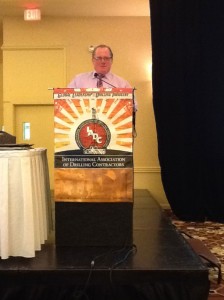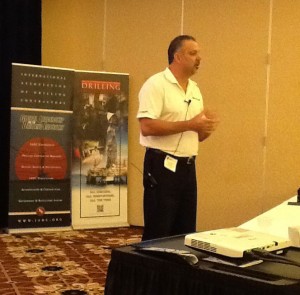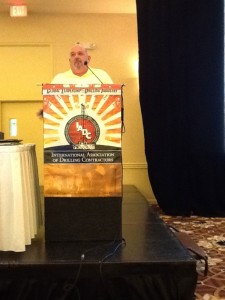Panel: Lift plans, JSAs build safer operations

By Katherine Scott, editorial coordinator
Lifting plans and JSAs help create safer lifting operations, but companies have found that reviewing the job once it’s completed better prepares the crew for future operations. “After every lift, we stop, take a few minutes, what did we do right, what did we do wrong, what can we do better next time?” Jonathan Henson, director – QM/HSE, Maersk Drilling, said. “There is nothing new under the sun here; it’s just how we go about it and how we do it and how we come to the conclusions that we come to.”
Mr Henson was among three other panelists – Jim McClellon, lifting and hoisting T/A, Shell E&P Americas; Ernest Richard Jr., staff EHS representative, Anadarko Petroleum; and Everett Tellez, senior engineering technician for cranes, ExxonMobil US Production – who shared insights into their companies’ approach to lift planning and JSAs at the 2012 IADC Lifting and Mechanical Handling Conference & Exhibition on 19 July in Lafayette, La. The session was moderated by John Pertgen, director – offshore regulatory & technical affairs of IADC.
“When you have a safety management system, it’s a one size fits all, so we came up with our own plan for our own rig,” Mr Henson said. The Maersk Developer semisubmersible is divided into nine separate areas around the main deck, covering all areas where crane activity can take place. Likewise, strategically located gate-type barriers prevent uncontrolled access to zones affected by specific crane operations.

Although largely seen as useful, lift planning can sometimes encounter pushback from crews. “How do you incorporate lift planning into what everybody considers to be routine?” Mr McClellon asked. Such pushback must be addressed, because the importance of lift planning can’t be underestimated. “About four out of five incidents will in some way have an element of a problem with lift planning,” he said.
In 2010, Shell implemented four ways to improve lifts: a lift planning tool, a lift categorization matrix, designated lift areas and lift planning forms. Together they help crews zero in on what it takes to plan a load, he said.
While a lift plan builds standards for lifting operations, a JSA looks more in-depth at specific jobs, helping the rig crew to determine risks before they become incidents. “What is the first thing we look for after an incident occurs, generally? We want to see that JSA,” Mr Richard said. “We want to make sure that hazard was identified and see if any sort of mitigations or controls were put in place to be able to work around that hazard.”
It’s also vital that crews revisit the JSA during the task as things change. “Sometimes we get extra personnel to come help, and at that point, the job has to stop, everyone re-reviews the JSA and gets on the same page and then that task can continue again.”

Signing the JSA is another necessary step. “By signing the JSA, we’re saying that I understand fully that JSA, and I understand the hazards, and I understand how to control them,” Mr Richard said, but he advised against having signatures for the sake of having signatures. Instead, people should be part of the job and read what’s being signed.
“We’ve all done a JSA. We all have our own ways of doing a JSA,” Mr Tellez said, but the main goal should always be to understand how to do a job without anyone getting hurt. It’s important to have everyone involved and to take a task step-by-step; there’s a certain amount of accountability assigned to each person, he explained.
Mr Tellez also said it’s important to know the difference between the normal procedure and the JSA, which focuses on hazards. “The normal procedure is how you are going to do the job, and the JSA is how you’re going to do it safer.”

One thing that can be missed on the JSA is the clean-up, Mr Tellez said. “After you’re through with a job, that’s when somebody could get hurt. They’re picking up the tool incorrectly, which was not addressed in the JSA. That’s why the JSA is reviewed at the end of the job. It helps you out the next time.”




